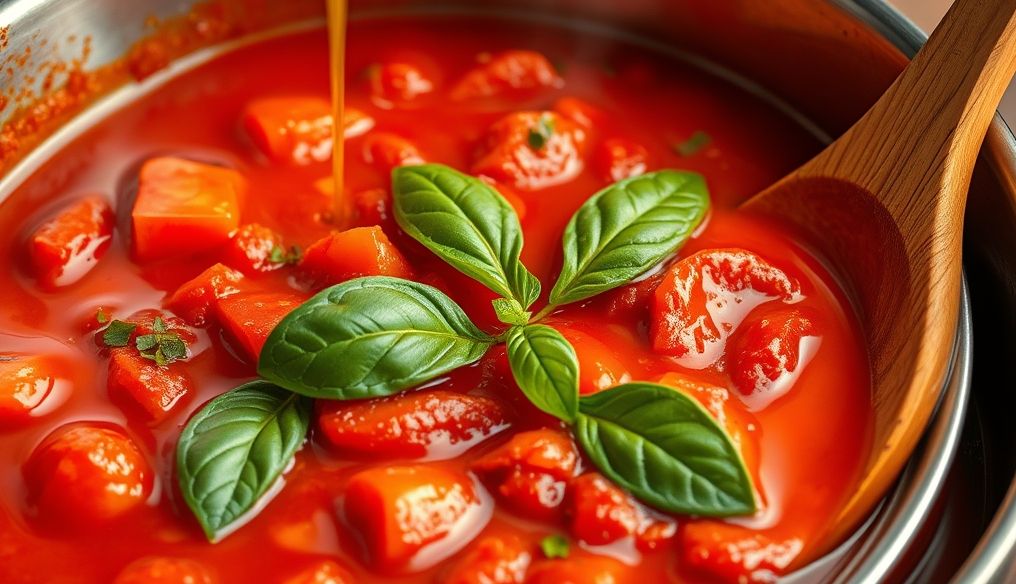Introduction: The Magic of Tomato Sauce
Tomato sauce is the cornerstone of many classic Italian dishes, especially pasta. But what makes a tomato sauce "perfect"? It's all about the balance of fresh ingredients, the right cooking technique, and a little bit of patience. In this comprehensive guide, we'll explore every aspect of making the perfect tomato sauce for pasta, from choosing the right tomatoes to adding the finishing touches that elevate the dish.
Chapter 1: Choosing the Perfect Tomatoes
The foundation of any great tomato sauce is the tomatoes themselves. Here are some common types and how to choose the best:
- San Marzano Tomatoes: Widely considered the best for making sauce. They have a thick flesh, few seeds, and a natural sweetness. Look for canned tomatoes labeled DOP (Denominazione di Origine Protetta) to ensure authenticity.
- Roma Tomatoes: Another excellent choice, widely available and flavorful.
- Cherry and Grape Tomatoes: Can be used to add sweetness and complexity to the sauce. Roast them before adding to enhance their flavor.
- Fresh vs. Canned Tomatoes: While fresh tomatoes are ideal during their season, high-quality canned tomatoes (especially San Marzano) are often better than out-of-season fresh tomatoes.
Tips for Choosing Tomatoes:
- Fresh Tomatoes: Look for tomatoes that are deep red in color, slightly firm, and heavy for their size. Avoid tomatoes with bruises or soft spots.
- Canned Tomatoes: Choose whole peeled tomatoes in tomato juice or puree. Avoid canned tomatoes with added ingredients like sugar or preservatives.
Chapter 2: Other Essential Ingredients
In addition to tomatoes, there are a few other essential ingredients that contribute to the flavor of the perfect tomato sauce:
- Olive Oil: Use high-quality extra virgin olive oil for a rich, fruity flavor.
- Garlic: Freshly minced garlic is a must. Don't overcook it, or it will become bitter.
- Onion: Finely chopped onion adds sweetness and depth.
- Herbs: Fresh basil and oregano are classic herbs that complement the flavor of tomatoes. Dried herbs can be used if fresh are not available, but use them sparingly.
- Salt and Pepper: Seasoning the sauce properly is essential. Use sea salt or kosher salt for best results.
- Sugar (Optional): A pinch of sugar helps to balance the acidity of the tomatoes.
Chapter 3: Essential Cooking Techniques
How you cook the tomato sauce is just as important as the ingredients you use. Here are some essential techniques:
- Start with Aromatic Oil: Heat olive oil in a large pot over medium heat. Add the minced garlic and onion and cook until they are soft and translucent, being careful not to burn them.
- Add the Tomatoes: Add the tomatoes (fresh or canned) to the pot. If using whole canned tomatoes, crush them with a wooden spoon or potato masher.
- Simmer Slowly: Reduce the heat to low and let the sauce simmer for at least an hour, or even longer. The longer it simmers, the more the flavors will develop and deepen.
- Seasoning: After about 30 minutes of simmering, add the salt, pepper, herbs, and sugar (if using). Taste the sauce and adjust the seasonings as needed.
- Stir Regularly: Stir the sauce regularly to prevent it from sticking to the bottom and burning.
Chapter 4: Adding Depth and Complexity
For a more complex tomato sauce, you can add some additional ingredients:
- Tomato Paste: Adding a tablespoon or two of tomato paste to the cooked onions and garlic enhances the tomato flavor. Cook it for a few minutes before adding the tomatoes to remove the acidity.
- Red Wine: A quarter cup of dry red wine can add depth and richness. Let it evaporate before adding the tomatoes.
- Vegetable or Chicken Broth: A little broth can help to thin the sauce and add more flavor.
- Red Pepper Flakes: A pinch of red pepper flakes adds a subtle heat.
Chapter 5: Refining the Texture
The ideal texture of tomato sauce depends on personal preference. Here are some ways to achieve the desired texture:
- Thick Sauce: Let the sauce simmer for a longer time to reduce the moisture. You can also add a little cornstarch mixed with cold water.
- Smooth Sauce: Use an immersion blender or regular blender to puree the sauce until smooth. If using a regular blender, fill the jar only partially and leave a vent for steam to escape to prevent explosions.
- Chunky Sauce: Leave the sauce chunky as is after cooking. If using whole canned tomatoes, crush them only slightly.
Chapter 6: Additional Tips and Tricks
- Use a Heavy-Bottomed Pot: This helps to distribute the heat evenly and prevents the sauce from sticking.
- Don't Overcook: Overcooking can make the sauce bitter.
- Taste and Adjust: Taste the sauce regularly while it's simmering and adjust the seasonings as needed.
- Refrigerating: Tomato sauce can be refrigerated in an airtight container for up to 5 days.
- Freezing: Tomato sauce can be frozen in an airtight container for up to 3 months.
Chapter 7: Serving the Perfect Tomato Sauce
Once your tomato sauce is ready, it's time to serve it with your favorite pasta. Here are some suggestions:
- Spaghetti: A classic dish that never disappoints.
- Penne: The perfect pasta shape for capturing the sauce.
- Fusilli: A great spiral shape that holds the sauce well.
- Tortellini: A delicious stuffed pasta that pairs perfectly with tomato sauce.
For a Perfect Serving:
- Cook the pasta until it is "al dente."
- Drain the pasta, reserving some of the cooking water.
- Add the pasta to the pot with the tomato sauce.
- Toss the pasta and sauce together, adding a little of the cooking water if needed to thin the sauce.
- Serve the pasta with a sprinkle of grated Parmesan cheese and fresh basil leaves.
Chapter 8: Basic Tomato Sauce Recipe
This is a basic tomato sauce recipe that can be modified to your liking:
Ingredients:
- 2 tablespoons extra virgin olive oil
- 2 cloves garlic, minced
- 1 medium onion, finely chopped
- 1 (28-ounce) can whole peeled tomatoes, San Marzano preferred
- 1 tablespoon tomato paste
- 1 teaspoon sugar (optional)
- 1/2 teaspoon dried oregano
- Salt and freshly ground black pepper, to taste
- Fresh basil leaves, for garnish
Instructions:
- Heat the olive oil in a large pot over medium heat. Add the garlic and onion and cook until they are soft, about 5 minutes.
- Add the tomato paste and cook for 1 minute, stirring constantly.
- Add the canned tomatoes, sugar (if using), oregano, salt, and pepper. Crush the tomatoes with a wooden spoon.
- Reduce the heat to low and let the sauce simmer for at least 1 hour, or even longer, stirring occasionally.
- Taste the sauce and adjust the seasonings as needed.
- Serve the sauce with your favorite pasta and garnish with fresh basil leaves.
Enjoy making this delicious sauce!




